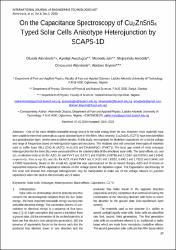On the Capacitance Spectroscopy of Cu2ZnSnS4 Typed Solar Cells Anisotype Heterojunction by SCAPS-1D

Göster/
Tarih
2020Yazar
Akinrinola, OlusolaAwodugba, Ayodeji
Jain, Momodu
Awodele, Mojoyinola
Akinrinola, Omowunmi
Ibiyemi, Abideen
Üst veri
Tüm öğe kaydını gösterÖzet
One of the most reliable renewable energy source is the solar energy from the sun. However, most materials have been unable to meet their potentials as a good absorber layer in thin films. Most recently, Cu2ZnSnS4 (CZTS) have been identified as a good absorber layer, yet the same problem persists. In this study, we examined the depletion capacitance vis-a-vis the voltage and range of frequencies based on heterojunction types and structures. The modeled solar cell consisted three types of materials used as buffer layer (BL) (ZnO:Al (AZO), In2S3 (IS) and CH3NH3PbCl3 (PVKT)). The band gap model of n/n/p anisotype heterojunction for the three BLs were constructed from the obtained data of the simulated solar cells. The band offsets ∆EC and ∆EV in electron-volts at n/n for AZO, IS and PVKT are; 0.07071 and 0.18794, 0.09768 and 0.72367 and 0.67541 and 2.54541 respectively. Also, at n/p ∆EC and ∆EV for AZO, IS and PVKT are; 0.14251 and 1.93251, 0.49011 and 1.73011 and 0.34041 and 1.73920 respectively. Based on the trivial AC signal that was superimposed on the dc biased charges, AZO and IS shows an exponential response of the capacitance reliance on the voltage across the depletion region. The Capacitance spectroscopy of this solar cell showed that anisotype heterojunction may be manipulated to make use of the voltage reliance on junction capacitance when the need to electronically vary it arises.
Cilt
6Sayı
3Bağlantı
https://hdl.handle.net/11363/2603Koleksiyonlar
Aşağıdaki lisans dosyası bu öğe ile ilişkilidir:

















